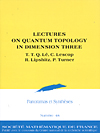- About MAA
- Membership
- MAA Publications
- Periodicals
- Blogs
- MAA Book Series
- MAA Press (an imprint of the AMS)
- MAA Notes
- MAA Reviews
- Mathematical Communication
- Information for Libraries
- Author Resources
- Advertise with MAA
- Meetings
- Competitions
- Programs
- Communities
- MAA Sections
- SIGMAA
- MAA Connect
- Students
- MAA Awards
- Awards Booklets
- Writing Awards
- Teaching Awards
- Service Awards
- Research Awards
- Lecture Awards
- Putnam Competition Individual and Team Winners
- D. E. Shaw Group AMC 8 Awards & Certificates
- Maryam Mirzakhani AMC 10 A Awards & Certificates
- Two Sigma AMC 10 B Awards & Certificates
- Jane Street AMC 12 A Awards & Certificates
- Akamai AMC 12 B Awards & Certificates
- High School Teachers
- News
You are here
Lectures on Quantum Topology in Dimension Three

Publisher:
Société Mathématique de France
Publication Date:
2017
Number of Pages:
174
Format:
Paperback
Series:
Panoramas et Synthèses 48
ISBN:
9782856298428
Category:
Monograph
[Reviewed by , on ]
Michael Berg
07/4/2017
In 1989 Edward Witten published a beautiful and important paper, “Quantum Field Theory and the Jones Polynomial.” Written as a response to questions raised by Sir Michael Atiyah on the occasion of the recent Hermann Weyl Symposium, the article gives a method for computing values of Jones polynomials (attached to knots and links) by means of what is now generally called topological quantum field theory (TQFT) in dimension 2+1. This means that if you have a suitable smooth 2-manifold, say, a cobordism, thought of as living in the boundary of a 3-manifold containing a knot or link in a special way — there should be suitable interaction with the 2-dimensional boundary — then doing axiomatic (!) quantum field theory on the arrangement gives wonderful information about the indicated knot or link. It ultimately all comes down to Chern-Simons theory: what runs the TQFT is a Chern-Simons action defining a Feynman integral formalism within a Yang-Mills framework, and then it’s off to the races.
In any case, what we are dealing with here is one of the central themes of recent and current low-dimensional topology and knot theory, with the major geometers in the game including Simon Donaldson, Graeme Segal, and of course the aforementioned Michael Atiyah, who happens to be the others’ doctoral advisor. This relatively recent cross-fertilization between quantum field theory and geometry/low-dimensional topology has been remarkably fecund, and the book under review is a contribution (and a fine, if high-level, introduction) to this very active field of research.
The beauty of the subject, and its profound reach, can already be gleaned just from the topics covered in the lectures that make up the book. The first lecture, by Christine Lescop, is an introduction, for non-specialists, to the AJ-conjecture, Khovanov homology, and Heegard-Floer homology. The AJ conjecture “relates generalizations of the Jones polynomial to the Cooper-Gillet-Long-Shalen A-polynomial, which is defined from \(\mathrm{SL}_2(\mathbb{C})\)-representation spaces of link exterior fundamental groups” (cf. the book’s back cover) … “Khovanov defined a homology theory for knots [in] \(\mathbb{R}^3\) whose Euler characteristic is the Jones polynomial” (loc.cit.), and Heegard-Floer homology is, in the words of Robert Lipshitz (the fourth and closing lecture, see p. 131), “a collection of tools in low-dimensional topology” which he employs in connection with knot surgery; additionally he addresses connections between Heegard-Floer homology and Khovanov homology. In the preceding (third) lecture, Paul Turner presents “A hitchhiker’s guide to Khovanov homology,” very much in the spirit of these lectures: as mentioned above, it’s for non-specialists. And this even applies to the remaining, second, lecture, in which Thank T. Q. Lê talks about (colored) Jones polynomials.
This is very exciting and seductive stuff: we’re in low dimensions, so we can draw things, at least in principle (knots can be, well, very knotty), and there are all sorts of very cool mathematical things that get to play the game. Clearly these lectures, while for non-specialists, are not for rookies. You should have some facility with such things as homology, low-dimensional topology even if only en passant (I have the good fortune of having two neighbors in my department who are low-dimensional topologists focusing on knot theory: department and college seminars are pretty forgiving, after all), and a decent amount of geometry/topology and algebra (at the graduate school level). It would also be nice if French were not an obstacle since Lescop’s article is not to be missed. All in all, if this sort of mathematics is your cup of tea, this is oojah cum spiff (with apologies to P. G. Wodehouse).
Michael Berg is Professor of Mathematics at Loyola Marymount University in Los Angeles, CA.
Introduction à quelques invariants des variétés de dimension  et de leurs entrelacs
et de leurs entrelacs
Christine Lescop
The colored Jones polynomial and the AJ conjecture
Thang T. Q. Lê
A hitchhiker's guide to Khovanov homology
Paul Turner
Heegaard Floer homologies
Robert Lipshitz
- Log in to post comments




